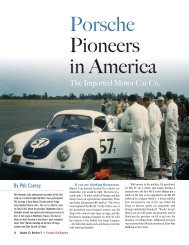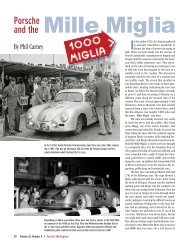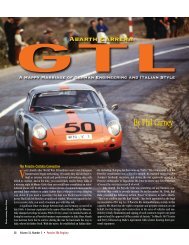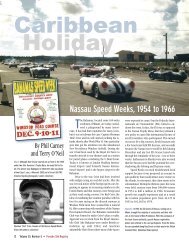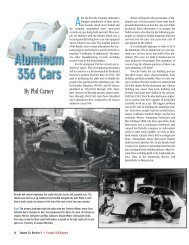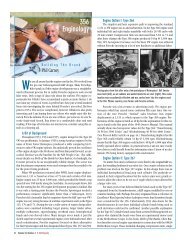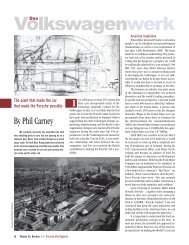You also want an ePaper? Increase the reach of your titles
YUMPU automatically turns print PDFs into web optimized ePapers that Google loves.
and for the purposes of this article about Porsche and <strong>OSCA</strong> only the first<br />
period is significant to the story. Only sports cars with large engines captured<br />
the WSC title during this time frame with Ferrari holding the title<br />
seven times in the first nine years. That was beca<strong>us</strong>e the point system was<br />
biased towards overall winners instead of class winners. Some race organizers<br />
recognized this skew and awarded additional recognition aimed at<br />
leveling the notoriety. For example, both Le Mans and Sebring bestowed<br />
an “Index of Performance” reward to the car that achieved the highest actual<br />
mileage compared to a preset distance that was a function of engine<br />
size. While such an award may make sense to the technical community, it<br />
never really caught on with the general public.<br />
The first <strong>OSCA</strong>s were brought into the U.S. privately in 1952. The Momo Corporation<br />
and Luigi Chinetti started importing them officially soon afterwards. In<br />
the western U.S., Edgar Fronteras became America’s distributor/dealer with<br />
b<strong>us</strong>iness associates Bumpy Bell and Chapman at ALMAR Motors in Tucson.<br />
Two videos from the 1954 Sebring<br />
12 Hour Race can be seen on<br />
YouTube. They’re grainy<br />
and short but give a marvelo<strong>us</strong><br />
feel for the scary simplicity of racing<br />
in that era. Search “Sebring 12<br />
hour 1954” at YouTube.<br />
Vid<br />
Hit<br />
Whoops, a little spin by Rees Makins driving one of his MT4s at Watkins Glen in<br />
1954. This car was equipped with a 1,092 cc engine and ran in G MOD. The deviation<br />
cost Makins dearly and he crossed the finish line behind two Siatas. (Alix<br />
Lafontant © Carl Goodwin)<br />
First Match Up<br />
The Argentine Grand Prix was first held in 1953 and was sufficiently<br />
successful that the C.S.I. decided it would open its 1954 WSC season with<br />
a 1000 Km (621.4 miles) race in Buenos Aires. It was the first opportunity<br />
for <strong>OSCA</strong> and Porsche to battle head-to-head in the series. There were a<br />
total of six Type 550s entered and four were equipped with new four-cam<br />
engines. Two MT4 <strong>OSCA</strong>s were on the starting grid but one was powered<br />
by an 1,100-cc engine while the other ho<strong>us</strong>ed a 1,350 cc power plant. All<br />
of the cars, Porsches and <strong>OSCA</strong>s, were classified in the under-1.5 liter sports<br />
category. It is unsurprising that Porsche took the class win with a <strong>Spyder</strong><br />
entered by Jaroslav Juhan – a part-time factory driver and the man instrumental<br />
in making the Porsche brand known in South American. The spoiler<br />
in the pudding was that the 1.1-liter <strong>OSCA</strong> took 2nd place in the same class<br />
with four other <strong>Spyder</strong>s trailing in the 3 though 6 positions. Should Porsche<br />
have taken this as an omen? Definitely.<br />
The next WSC race was j<strong>us</strong>t six weeks later in Sebring, Florida. Both<br />
marques were out in force and the combatants could not have been more<br />
evenly matched. Four 550s and one 356 were on the grid in the sport 1.5<br />
class while six MT4 <strong>OSCA</strong>s showed up in engine sizes of 1100, 1350, and<br />
1450 cc. The race results shocked almost everyone. Not only did Briggs<br />
Cunningham’s MT4 driven by Stirling Moss win its class, it also took first<br />
place overall. Briggs was subtly proud simply stating, “It pleased all of <strong>us</strong><br />
to win over so many larger cars at Sebring.” Other <strong>OSCA</strong> results were<br />
equally impressive with second and third S1.5 class placements. For <strong>OSCA</strong>,<br />
the icing on the cake was that their group took the top four spots in the<br />
Index of Performance. The best Porsche <strong>Spyder</strong> accomplishment was tenth<br />
overall (fourth in class) behind a 1.1 liter <strong>OSCA</strong>. Road & Track in their review<br />
declared “the <strong>OSCA</strong>s stole the entire show.”<br />
The next matchup was the Mille Miglia. As described in the past March<br />
issue, the team of Herrmann and Linge campaigned their 550 spectacularly<br />
taking the S1.5 class win. Twenty minutes behind them was an MT4 that<br />
had been driven single handedly the entire 1,000 miles by Giulio Cabianca.<br />
The Le Mans race a month later should have been very telling. The Porsche<br />
factory entered three <strong>Spyder</strong>s and the Maserati brothers entered two MT4s<br />
in the same class. Although two <strong>Spyder</strong>s dropped out with engine problems,<br />
Porsche took the class win. As for the <strong>OSCA</strong>s, one of their cars was DNF<br />
due to an accident while the second was disqualified for receiving outside<br />
assistance. Statistically it was still difficult to figure out the better car. The<br />
last WSC 1954 race was the Carrera Panamerica. Six Porsches were entered<br />
in the Sport 1500 class; four 550s and two 356s. Three MT4s were in the<br />
same class. The Mexican race results seemed to provide a clearer picture<br />
of the Porsche-<strong>OSCA</strong> competition. <strong>Spyder</strong>s finished in class 1-2-4-5. One<br />
<strong>OSCA</strong> occupied the third position while the other two were DNF. The year<br />
1954 might be considered a draw between the two rivals. Perhaps 1955<br />
would provide a more definitive answer as to the best racer in the 1.5 liter<br />
Sports Car class.<br />
Left: There were a lot of <strong>OSCA</strong>s and Porsches at Watkins Glen in the fall of 1954.<br />
Frank Bott takes the checkered flag driving one of a Rees Makins’ MT4 1500 in the<br />
Queen Catherine Cup race. (Alix Lafontant photo, Carl Goodwin collection).<br />
16 Volume 36, Number 3 • Porsche 356 Registry



